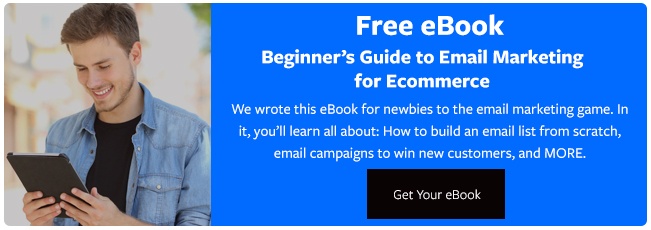
Do you segment your email lists? If you’re like a lot of ecommerce business owners, you might think it’s unnecessary. Your email subscribers are all customers, and they all want the same things, right?
Let’s take a step back and talk about what segmentation actually is. It may sound complicated, but segmentation is nothing more than splitting up your email lists into smaller groups that share characteristics or habits.
In this article we'll show you why customer's list segmentation is important, and will give you 10 ways to segment your customers to help you increase conversions in your email campaigns.
The Case for Customer Segmentation
In the email marketing world, segmentation often comes as an afterthought. Plenty of marketers don’t consider it a vital step in the email marketing process. That’s a mistake.
Why? When DMA surveyed marketers, they found that 30% of email revenue came from segmented campaigns – the most of any one campaign. Help Scout found that segmented campaigns achieve 30% more opens, and MailChimp reported 65% more clicks. You read that right – sixty-five percent. Not to mention 9% fewer unsubscribes.
The conclusion? If you aren’t segmenting emails, “you’re throwing away 30% of the value of your email marketing campaigns.”
How can something as simple as segmenting your email list lead to numbers like that? Segmentation allows you to tap into the specific attitudes and desires of each subscriber. That means you can craft hyper-targeted email campaigns that speak directly to each segment. It helps you personalize your offers so each email has a higher chance of converting subscribers in that segment.
In short, segmentation helps you create better campaigns, so it makes sense that those campaigns are more effective.
Ways to Segment Your Customer's List
We already mentioned the goal of segmentation – to create groups that help you better target email campaigns and offers. There are a number of ways you can segment subscribers to achieve that end.
Segmenting by personal characteristics
1. Location
Location seems simplistic, but it can tell you a lot about what your customers need and when. It determines the clothing they wear, the food they eat, how they speak, even sometimes their interests. That means, depending on the region, you can promote seasonal items and offer regional favorites. You can even tailor the copy of your emails to reflect local slang.
2. Device
On the one hand, segmenting your email lists by device makes sense because it helps ensure that each email looks its best on the device subscribers are likely to see it on. That’s important. The device subscribers most often use can also give you a hint as to other demographic information, like age, too.
3. Interests
If you only segment by one characteristic, make it interests. The hobbies, sports, and other entertainment your email subscribers are interested in is a treasure trove of data to help you better market to them and craft offers that will entice these customers in particular. The more you can tap into their outside interests, the better chance you have at converting them.
4. Psychographics
Psychographics refer to things like the values, opinions, and lifestyle of your subscribers. Some of these can be hard to measure outright, but understanding this aspect of your customers’ lives makes it easier to write email that speak directly to them. And email offers are a lot more effective when subscribers see a little of themselves in the copy.
Segmenting by shopping habits
5. Purchase history
Segmenting based on the customer’s previous buying history is one of the most effective ways to use email to grow your bottom line. Cross- and upsell emails use this information to promote additional products that go with items they’ve purchased already or similar items bought by other customers in the same segment.
6. Buying persona
If you’re not familiar with buyer personas, they’re your best friend as a marketer. Personas are complete profiles of your most common customers, and they combine psychographics, demographics, and shopping habits into one, neat little package. Segmenting your email lists by persona can lead to your most highly-targeted and effective campaigns to date.
7. Time as a customer or subscriber
We love customers and subscribers – both new and old. But it’s no secret that their needs and the way they react to certain offers varies depending on how familiar they are with your brand and how long they’ve worked with you. New subscribers may need incentive to become a first-time customer. Long-term customers may need a reminder to buy again.
8. Engagement level
Speaking of reminders, you can target different email campaigns depending on how engaged subscribers are. Someone who opens your emails immediately every time they hit their inbox is an easier sell than the person who sends you to the spam folder. When engagement starts dropping off, these subscribers are good candidates for a re-engagement campaign.
9. Stage in the sales funnel
Segmenting by sales funnel stages is similar to time as a subscriber, but it relies more on concrete actions (like making a purchase). This is extra useful if you’re using email to promote content – subscribers who are just getting to know your brand need a different approach than those who’ve already become customers.
10. Promoters
One of your most powerful weapons as a marketer is word of mouth. By identifying those customers who are just wild for your online shop, you can tap into their networks. Creating a segment of promoters and brand advocates can help you get them talking and spreading the word about your brand.
Are you throwing away leads?
There’s no denying that segmented email campaigns can take your email strategy to a totally new level. By grouping subscribers based on what they have in common, you can target more effective offers, better serve your customers, and grow revenue – so start leveraging that email list to the fullest!





Leave a reply or comment below